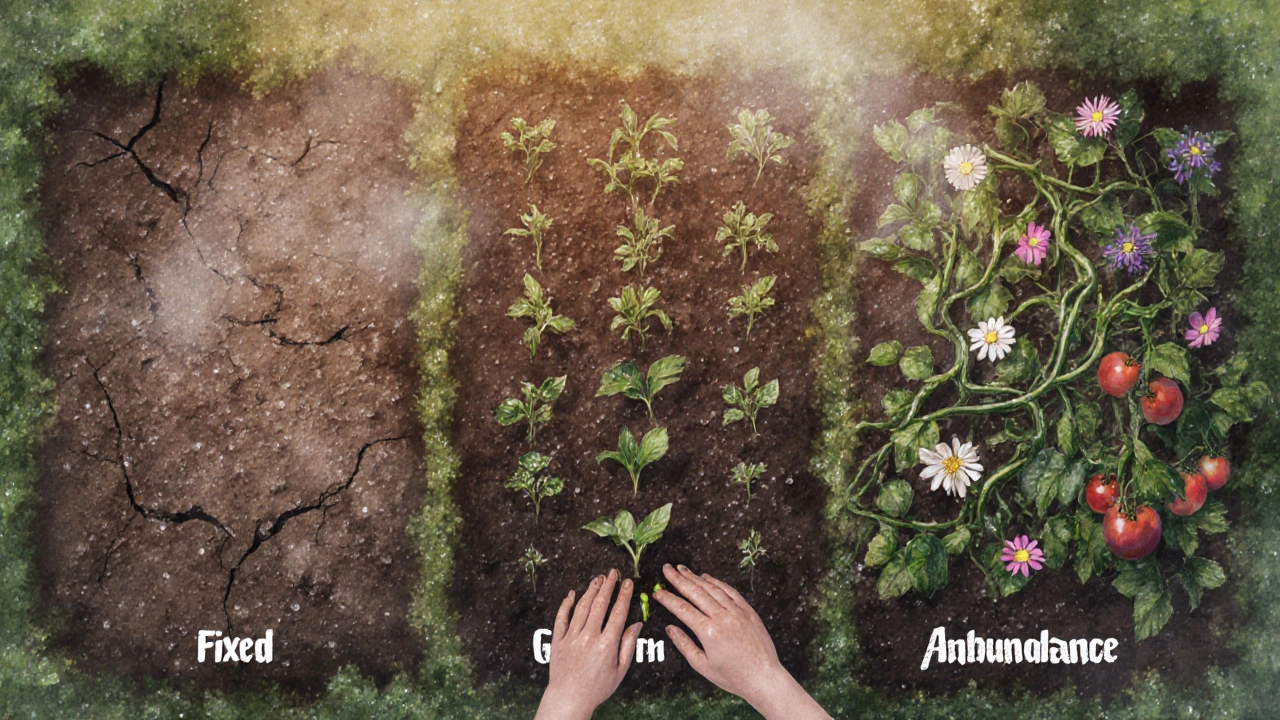Mindset Assessment Quiz
How Do You See Challenges?
Select the option that best describes your reaction:
When Others Succeed...
How do you typically react when someone achieves something you want?
Your Self-Talk About Failure
What do you say when you make a mistake?
Sharing Knowledge
How do you approach sharing your skills or resources?
Your Growth Beliefs
What do you believe about your abilities?
Your Mindset Profile
Your dominant mindsets:
Your next step:
Think about the last time you failed at something. Did you tell yourself you weren’t cut out for it? Or did you wonder what you could do differently next time? The difference between those two reactions isn’t luck or talent-it’s your mindset. And the truth is, most people operate on just three main mindsets without even realizing it. These mindsets don’t just affect how you learn or work. They shape your relationships, your stress levels, your confidence, and even how long you stick with goals.
The Fixed Mindset: Believing Ability Is Set in Stone
The fixed mindset is the quiet voice that says, "I’m just not good at this." It’s the belief that your intelligence, talent, and personality are locked in place. You either have it or you don’t. This mindset shows up when you avoid challenges because you’re scared of looking stupid. It’s why people quit learning new skills after one bad experience. They don’t see failure as feedback-they see it as proof they’re inadequate.
Psychologist Carol Dweck studied this for decades. In one experiment, kids praised for being "smart" chose easier tasks next time. They didn’t want to risk losing their "smart" label. Kids praised for effort? They picked harder challenges. The fixed mindset isn’t about being lazy. It’s about fear. Fear that if you try and fail, you’re exposing a flaw you can’t fix.
This mindset shows up in workplaces, classrooms, and homes. Managers with fixed mindsets assume talent is rare and hoard top performers. Parents with fixed mindsets say, "You’re a natural at math," instead of, "You worked hard on that problem." Both statements sound positive, but only one builds resilience.
The Growth Mindset: Learning Is a Lifelong Process
The growth mindset flips the script. It’s the belief that abilities can be developed through effort, strategy, and persistence. It doesn’t mean everyone can become a genius-but it does mean everyone can improve. This mindset sees effort as the path to mastery, not a sign of weakness. Mistakes? They’re data. Setbacks? They’re detours, not dead ends.
People with a growth mindset don’t avoid challenges-they seek them. They ask for feedback because they want to get better, not to be validated. They look at others’ success not as a threat, but as inspiration. In schools, students with this mindset outperform peers with equal talent because they keep going when things get hard. In business, teams with growth mindsets innovate faster because they’re not afraid to test risky ideas.
Here’s the catch: you can’t just say you have a growth mindset. You have to act like it. That means saying "I haven’t mastered this yet" instead of "I can’t do this." It means praising effort over results. It means staying curious when you’re stuck. This mindset isn’t about being positive-it’s about being persistent.

The Abundance Mindset: There’s Enough for Everyone
While the fixed and growth mindsets focus on personal ability, the abundance mindset changes how you see the world. It’s the belief that there’s enough success, opportunity, love, and resources for everyone. It’s the opposite of scarcity thinking-the fear that if someone else wins, you lose.
People with an abundance mindset celebrate others’ wins. They share ideas, make introductions, and collaborate instead of compete. They don’t hoard knowledge because they know sharing it multiplies value. In relationships, this mindset means trusting that love isn’t limited. In business, it means building partnerships instead of guarding secrets.
Scarcity thinking shows up in small ways: "I can’t afford to help that person-they’ll just take advantage." Or, "If I share my method, someone else will copy me." But abundance thinkers say, "What if helping them creates more opportunity for me?" They know that generosity doesn’t deplete-it expands.
This mindset doesn’t come from being rich or lucky. It comes from security. When you believe your worth isn’t tied to external validation, you stop seeing the world as a zero-sum game. You stop comparing yourself to others. You stop hoarding. And that’s when real growth begins.
How These Mindsets Interact
These three mindsets don’t exist in isolation. They stack. Someone with a growth mindset but a scarcity mentality might work hard but resent others’ success. Someone with an abundance mindset but a fixed mindset might be generous but avoid challenges because they don’t believe they can improve.
The most powerful combination? Growth + Abundance. You believe you can get better-and you’re excited when others do too. You share your progress. You ask for help. You celebrate milestones, even if they’re not yours. This combo turns personal development into collective momentum.
Think of it like a garden. A fixed mindset says, "My soil is bad-I’ll never grow anything." A growth mindset says, "I’ll test different fertilizers and learn what works." An abundance mindset says, "I’ll share seeds with my neighbor and we’ll both harvest more."

How to Shift Your Mindset
Changing your mindset isn’t about positive affirmations. It’s about rewiring your habits. Start small.
- Notice your self-talk. When you fail, what do you say? "I’m terrible at this"? That’s fixed. "What did I miss?"? That’s growth.
- Replace "I can’t" with "I haven’t yet." Language shapes thought. The word "yet" adds time. It implies progress.
- Find one person to celebrate. Send a message to someone who succeeded-really mean it. This trains your brain to see success as shared, not stolen.
- Take one small risk this week. Something that scares you. Not because you’ll win-but because you’ll learn.
- Reflect weekly. Write down one thing you learned from a mistake. No judgment. Just observation.
These shifts don’t happen overnight. But over months, they change everything. Your confidence grows because you stop fearing failure. Your relationships deepen because you stop comparing. Your goals become more ambitious because you believe you can evolve.
What Happens When You Master These Mindsets?
People who live with a growth and abundance mindset don’t just survive-they thrive. They’re the ones who start businesses after layoffs. Who learn new languages in their 50s. Who stay married through hard times because they believe love can grow. They don’t wait for the perfect moment. They create it.
And here’s the quiet truth: you don’t need to be extraordinary to develop these mindsets. You just need to be consistent. One small shift in how you think about failure. One moment of genuine praise for someone else. One time you try again after a setback.
That’s how change happens. Not with a bang, but with a hundred quiet choices. And every one of those choices is yours to make.
Can you have more than one mindset at the same time?
Yes. Most people mix mindsets depending on the situation. You might have a growth mindset at work but a fixed mindset about your appearance. Or an abundance mindset in friendships but a scarcity mindset about money. The key is awareness. Once you notice which mindset is active in a situation, you can choose to shift it.
Is the abundance mindset just being naive or overly optimistic?
No. Abundance isn’t ignoring reality-it’s choosing to act as if opportunity exists even when it’s not obvious. A scarcity mindset says, "There’s only one promotion, so I have to fight for it." An abundance mindset says, "I’ll build skills so I create my own opportunity, and if someone else gets promoted, I’ll still be better off for trying." It’s strategic, not sentimental.
Can a fixed mindset be changed later in life?
Absolutely. The brain doesn’t stop changing when you turn 30. Studies show that adults who learn to reframe failure as feedback show measurable shifts in behavior within weeks. It’s harder if you’ve held a fixed mindset for decades-but not impossible. It just takes more repetition and patience.
What’s the biggest myth about growth mindset?
That effort alone guarantees success. Growth mindset isn’t just about working harder. It’s about working smarter. It’s about seeking feedback, adjusting strategy, and learning from others. If you’re grinding away at the same thing with no progress, you’re not being growth-minded-you’re being stubborn. True growth means adapting, not just enduring.
How do I know if I have an abundance mindset?
Ask yourself: Do I feel happy when someone else succeeds? Do I freely share resources or knowledge without expecting something back? Do I believe my success doesn’t depend on others failing? If you answer yes to these, you’re likely operating from abundance. If you feel jealous, competitive, or defensive, you might be slipping into scarcity.
If you’ve read this far, you’re already on the path. You didn’t just scroll past-you paused. That pause? That’s the first sign of a growth mindset. The next step? Try one small thing differently today. Not tomorrow. Today.






